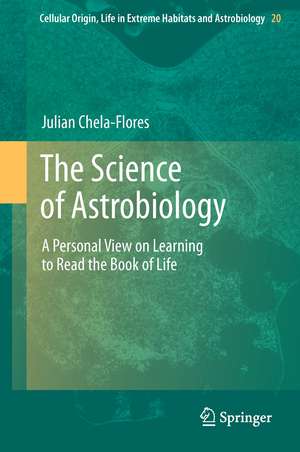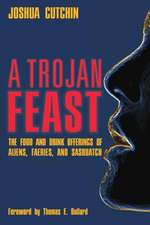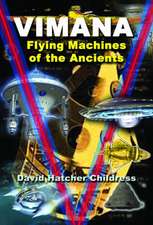The Science of Astrobiology: A Personal View on Learning to Read the Book of Life: Cellular Origin, Life in Extreme Habitats and Astrobiology, cartea 20
Autor Julian Chela-Floresen Limba Engleză Paperback – 26 noi 2013
| Toate formatele și edițiile | Preț | Express |
|---|---|---|
| Paperback (1) | 1219.94 lei 6-8 săpt. | |
| SPRINGER NETHERLANDS – 26 noi 2013 | 1219.94 lei 6-8 săpt. | |
| Hardback (1) | 1223.55 lei 6-8 săpt. | |
| SPRINGER NETHERLANDS – 28 iul 2011 | 1223.55 lei 6-8 săpt. |
Din seria Cellular Origin, Life in Extreme Habitats and Astrobiology
- 18%
 Preț: 1683.66 lei
Preț: 1683.66 lei - 5%
 Preț: 1440.04 lei
Preț: 1440.04 lei - 18%
 Preț: 1839.32 lei
Preț: 1839.32 lei - 18%
 Preț: 1848.33 lei
Preț: 1848.33 lei - 18%
 Preț: 1839.32 lei
Preț: 1839.32 lei - 18%
 Preț: 1222.27 lei
Preț: 1222.27 lei - 18%
 Preț: 1232.26 lei
Preț: 1232.26 lei - 18%
 Preț: 2098.03 lei
Preț: 2098.03 lei - 18%
 Preț: 1228.29 lei
Preț: 1228.29 lei - 18%
 Preț: 2111.46 lei
Preț: 2111.46 lei - 24%
 Preț: 1076.36 lei
Preț: 1076.36 lei - 18%
 Preț: 1828.11 lei
Preț: 1828.11 lei - 18%
 Preț: 951.14 lei
Preț: 951.14 lei - 18%
 Preț: 1235.08 lei
Preț: 1235.08 lei - 18%
 Preț: 1252.76 lei
Preț: 1252.76 lei - 18%
 Preț: 1263.01 lei
Preț: 1263.01 lei - 18%
 Preț: 956.50 lei
Preț: 956.50 lei - 18%
 Preț: 956.03 lei
Preț: 956.03 lei - 18%
 Preț: 1234.46 lei
Preț: 1234.46 lei - 18%
 Preț: 1122.58 lei
Preț: 1122.58 lei - 15%
 Preț: 646.11 lei
Preț: 646.11 lei - 18%
 Preț: 1840.91 lei
Preț: 1840.91 lei - 18%
 Preț: 1231.16 lei
Preț: 1231.16 lei - 18%
 Preț: 1251.50 lei
Preț: 1251.50 lei - 18%
 Preț: 961.41 lei
Preț: 961.41 lei
Preț: 1219.94 lei
Preț vechi: 1487.73 lei
-18% Nou
Puncte Express: 1830
Preț estimativ în valută:
233.43€ • 243.25$ • 193.28£
233.43€ • 243.25$ • 193.28£
Carte tipărită la comandă
Livrare economică 03-17 aprilie
Preluare comenzi: 021 569.72.76
Specificații
ISBN-13: 9789400737082
ISBN-10: 9400737084
Pagini: 364
Ilustrații: XXIV, 340 p.
Dimensiuni: 155 x 235 x 19 mm
Greutate: 0.51 kg
Ediția:2011
Editura: SPRINGER NETHERLANDS
Colecția Springer
Seria Cellular Origin, Life in Extreme Habitats and Astrobiology
Locul publicării:Dordrecht, Netherlands
ISBN-10: 9400737084
Pagini: 364
Ilustrații: XXIV, 340 p.
Dimensiuni: 155 x 235 x 19 mm
Greutate: 0.51 kg
Ediția:2011
Editura: SPRINGER NETHERLANDS
Colecția Springer
Seria Cellular Origin, Life in Extreme Habitats and Astrobiology
Locul publicării:Dordrecht, Netherlands
Public țintă
Upper undergraduateCuprins
Preface.- Acknowledgements.- Recommendations to the readers
Introduction: The cultural and scientific context of astrobiology.- The Book of life.- Part 1: The Origin of Life in the Universe.- Part 2: The Evolution of Life in the Universe.- Part 3: The Distribution of Life in the Universe.- Part 4: The Destiny of Life in the Universe
Epilogue: Learning to read the Book of Life: An interdisciplinary process; Acronyms and abbreviations.- Illustrated glossary; General index.- Index of illustrations.- Index of Tables.- Alphabetical index.- About the author.- Books by the author.
Introduction: The cultural and scientific context of astrobiology.- The Book of life.- Part 1: The Origin of Life in the Universe.- Part 2: The Evolution of Life in the Universe.- Part 3: The Distribution of Life in the Universe.- Part 4: The Destiny of Life in the Universe
Epilogue: Learning to read the Book of Life: An interdisciplinary process; Acronyms and abbreviations.- Illustrated glossary; General index.- Index of illustrations.- Index of Tables.- Alphabetical index.- About the author.- Books by the author.
Recenzii
From the reviews:
“Chela-Flores (Abdus Salam International Centre for Theoretical Physics, Italy) supplies up-to-date reviews of the astronomy (so viewers will know where to aim telescopes), a survey of early life on Earth … and a survey of solar system candidates. … Overall, a good volume to have on one’s library shelf and to function as a required reference in astrobiology courses. Summing Up: Recommended. All academic, general, and professional audiences.” (K. L. Schick, Choice, Vol. 49 (6), February, 2012)
“I strongly recommend this book, written by a real humanist, to any open-minded reader eager to consider “classical” astrobiology in its philosophical context. The book offers a very rare occasion to access the full dimension of astrobiology: origin, evolution, distribution and destiny of life in the Universe.” (André Brack, Origins of Life and Evolution of Biospheres, March, 2012)
“While reading this book, the origin-of-life professional will recognize its useful organization and summary of various components of astrobiology. … I found this book instructive and mind-opening. … The author is very successful in conveying that much can be gained in astrobiology by merging science with philosophy.” (Radu Popa, Astrobiology, Vol. 12 (10), 2012)
“Chela-Flores (Abdus Salam International Centre for Theoretical Physics, Italy) supplies up-to-date reviews of the astronomy (so viewers will know where to aim telescopes), a survey of early life on Earth … and a survey of solar system candidates. … Overall, a good volume to have on one’s library shelf and to function as a required reference in astrobiology courses. Summing Up: Recommended. All academic, general, and professional audiences.” (K. L. Schick, Choice, Vol. 49 (6), February, 2012)
“I strongly recommend this book, written by a real humanist, to any open-minded reader eager to consider “classical” astrobiology in its philosophical context. The book offers a very rare occasion to access the full dimension of astrobiology: origin, evolution, distribution and destiny of life in the Universe.” (André Brack, Origins of Life and Evolution of Biospheres, March, 2012)
“While reading this book, the origin-of-life professional will recognize its useful organization and summary of various components of astrobiology. … I found this book instructive and mind-opening. … The author is very successful in conveying that much can be gained in astrobiology by merging science with philosophy.” (Radu Popa, Astrobiology, Vol. 12 (10), 2012)
Textul de pe ultima copertă
Since the publication of The New Science of Astrobiology in the year 2001—the first edition of the present book—two significant events have taken place raising the subject from the beginning of the century to its present maturity. Firstly, in 2001 the Galileo Mission still had two years to complete its task, which turned out to be an outstanding survey of the Jovian system, especially of its intriguing satellite Europa. Secondly, the Cassini Huygens Mission was on its way to Saturn. Its present success has surpassed all the expectations of ESA and NASA. Cassini had been launched four years earlier and Huygens was to land on Titan three years after the publication of the first edition. Besides, astrobiologists had no idea that another satellite of Saturn, Enceladus, was going to force a tantalizing lure on the scientific community with its startling jets of water exuding an air of mystery, hinting at a submerged inhabitable ocean of salty water. Before the date of publication of The New Science of Astrobiology there was not an awareness of the Earth-like features of Titan. Besides, we still had to learn that Titan was the fifth body of the Solar System that possibly contained a water ocean, thus joining our planet and the three Galilean satellites other than Io.
As a multidisciplinary subject, astrobiology sometimes regretfully neglects to some extent the life sciences. There are many other aspects of our culture to keep in mind: chemical evolution, the earth sciences, the physical sciences, cutting-edge technology and the humanities that lie at its frontiers. The emphasis on our previous book made a modest attempt to set the scientific subject squarely amongst other sectors of culture. These boundaries are philosophy and theology, branches of the humanities asking similar questions to the basic issues that are astrobiology's main domain (the origin, evolution, distribution and destiny of lifein the universe). The present volume brings these issues up to date.
As a multidisciplinary subject, astrobiology sometimes regretfully neglects to some extent the life sciences. There are many other aspects of our culture to keep in mind: chemical evolution, the earth sciences, the physical sciences, cutting-edge technology and the humanities that lie at its frontiers. The emphasis on our previous book made a modest attempt to set the scientific subject squarely amongst other sectors of culture. These boundaries are philosophy and theology, branches of the humanities asking similar questions to the basic issues that are astrobiology's main domain (the origin, evolution, distribution and destiny of lifein the universe). The present volume brings these issues up to date.
Caracteristici
The book includes subjects missing in other discussions of astrobiology that help the reader to appreciate the limitations of our current understanding of astrobiology (philosophy and the current bases of cosmology) References in each chapter to the rich enclosed illustrated glossary help the reader to find his or her way through the vast array of disciplines that make up astrobiology Includes over 100 illustrations mostly in colour that lead specialists in diverse scientific areas, as well as in the humanities, gently and pleasantly into the most relevant arguments












